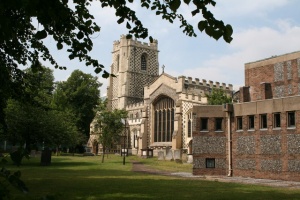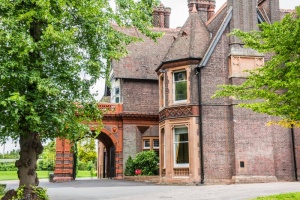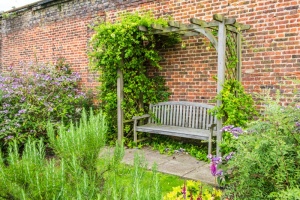
(c) Dr Neil Clifton
Although centred in the industrial belt of southern Bedfordshire and close to the outskirts of London's urban sprawl, Luton is a surprisingly "green" city, with a proud history of faring well in the annual "Britain in Bloom" competitions. Luton has no less than 7 landscaped parks and a variety of floral roundabouts punctuating the roadways.
Major Attractions:
- Stockwood Park
- Mossman Collection
- Luton Museum & Art Gallery
- St Mary's Church
- Luton Hoo Walled Garden
The area was settled as early as Paleolithic times, and there were Roman and Saxon towns here as well. At the time of the Domesday Book Luton had a population of 700.

Much of Luton's prosperity was based on its regular livestock markets, though by the 17th century these were being challenged by an emerging industry in straw plaiting.
The straw was often worked into straw hats, and the hat-making and brewing industries bolstered Luton's economy for many years. It was not until the 1930s that hat making ceased to be a major employer in Luton. More recently Luton is best known as the home of London Luton Airport, which is a major employer for the area.
St. Mary's Church was originally built in 931 AD, but that early Saxon church was replaced by the present one in the 12th century. Large sections of the exterior were remodelled in the 15th century in a chequer pattern of flint and stone. Cardinal Wolsey was a patron of the church, and the west door (1530) is named after him.
The interior is notable for its wonderful screens, especially the double-arched "Wenlock screen" on the north side, which came from Luton Hoo. Beneath the screen are the tombs of William Wenlock (d. 1392) and Lady Alice Rotherham. The 14th-century baptistery was presented by Queen Phillippa, wife of Edward III, when the crown held the living of St. Mary's.

Stockwood Park and conservatory is home to the Luton Craft Museum, Period Gardens, and the Mossman Collection of horse-drawn vehicles.
The Luton area is set near the Chiltern Area of Outstanding Natural Beauty. The Icknield Way long distance path runs through Luton on its way from Warden & Gallery Hills to Dunstable.
A riverside walk to London is waymarked through Luton town centre with tiles showing a swan motif.
The Luton Museum and Art Gallery is located in a Victorian mansion and showcases lace, costume, local and natural history and a special childhood exhibit. Luton has a long history of hat making, which is celebrated in a special hat gallery.
Stockwood Craft Museum explores life in rural Bedfordshire, with displays of country life, crafts and trades. The Period Gardens portray 900 years of English gardening history.
As part of the same complex, the Mossman Collection displays over 70 varieties of horse-drawn vehicles. In the same building, the Luton Transport Gallery brings the history of transport into the 20th century.
Just north of Luton is Sharpenhoe Clappers, an Iron Age hill fort with excellent views.
Related:
Bedfordshire Countryside
About Luton
Address: Luton,
Bedfordshire,
England
Attraction Type: Town
Location map
OS: TL090 213
Photo Credit: Dr Neil Clifton, licensed for reuse under the Creative Commons Licence
POPULAR POSTS
HERITAGE
 We've 'tagged' this attraction information to help you find related historic attractions and learn more about major time periods mentioned.
We've 'tagged' this attraction information to help you find related historic attractions and learn more about major time periods mentioned.
Find other attractions tagged with:
NEARBY HISTORIC ATTRACTIONS
Heritage Rated from 1- 5 (low to exceptional) on historic interest
Luton, St Mary's Church - 0.3 miles (Historic Church) ![]()
Wardown Park Museum - 1 miles (Museum) ![]()
Stockwood Discovery Centre - 1.1 miles (Museum) ![]()
Someries Castle - 1.9 miles (Castle) ![]()
Luton Hoo Walled Garden - 3.1 miles (Garden) ![]()
Dunstable Priory - 4.3 miles (Historic Church) ![]()
Dunstable Downs and Whipsnade Estate - 5.1 miles (Countryside) ![]()
Whipsnade Tree Cathedral - 5.5 miles (Cathedral) ![]()
Nearest Holiday Cottages to Luton:
Bletchley, Buckinghamshire
Sleeps: 6
Stay from: £759 - 2305



